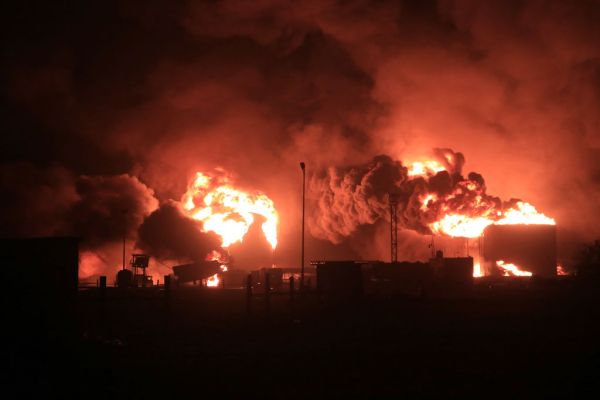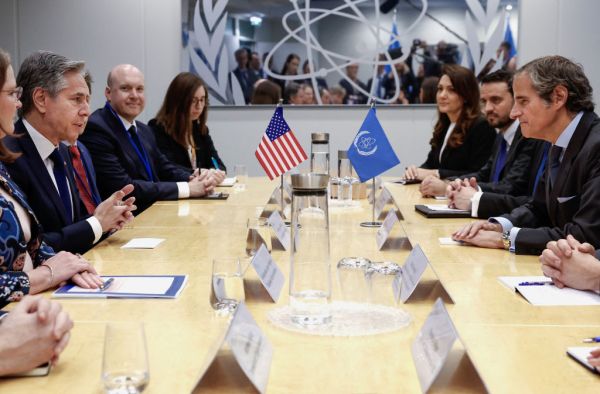On Wednesday, air raid sirens forced thousands in northern Israel into bomb shelters. It turned out to be a false alarm, but the fears were warranted. While Israel contends with Hamas to the south, any escalation in tensions between Israel and Lebanon-based Hezbollah all but guarantees the IDF would be fighting a multifront war against two Iran-backed terror organizations in the coming days and weeks.
More than 1,200 Israelis have been killed by Iran-backed Hamas terrorists since Saturday, the bloodiest episode in Israel’s history. The Wall Street Journal reported—and the Washington Post confirmed—that the regime in Iran funded, trained, and equipped Hamas, reportedly approving this operation a week ago. There are now reports that Iran is pressuring Hezbollah to attack Israel from Lebanon, attempting to engage Israel in a multifront war against two parts of Iran’s terror network.
Hezbollah is the most formidable, claiming to have 100,000 fighters. While Israel believes the number is significantly lower, many Hezbollah fighters have been battle-hardened over the past decade fighting in Syria. It is also the most heavily armed nonstate actor in the world. Its arsenal of 150,000 rockets in southern Lebanon—most of which are buried under civilian infrastructure—includes hundreds of precision guided missiles (PGM’s) that can hit a target with an accuracy of within 10 meters.
According to Israeli Defense Minister Yoav Gallant, Iran provides $100 million annually to Hamas and $700 million to Hezbollah. Iran has convened Hamas and Hezbollah leaders repeatedly in the past year, resolving to increase cooperation to attack Israel. Given Iran’s huge investment and close ties with the Lebanese terror organization, it is unclear how long Hezbollah can resist Tehran’s call to fully engage in the ongoing war.
In its Monday article breaking the news of Iranian involvement, the Wall Street Journal detailed how senior members of Hamas and Hezbollah claimed the terror groups had coordinated closely with Iran’s Islamic Revolutionary Guard Corps (IRGC) since August to plan the attack. On Monday, Israel’s Minister of Strategic Affairs Ron Dermer said that Israel was under the “working assumption” that Iran was directly involved in the planning of the devastating attack. Even if Hezbollah does not move in and create a multifront war, Israel will have to contend with the group after it deals with Hamas, which shares the same playbook.
In 2018, Israel uncovered a Hezbollah plot in advanced stages to take siege of northern villages and towns and kidnap hostages—just like the events that unfolded in Israel’s south on Saturday. After witnessing the latest massacre, citizens of northern Israel will not sleep easy knowing that an equally determined and much more potent foe lies on the other side of the northern security fence.
Although Hamas proved to be cunning and destructive over the past three days—and can use hostages to cause Israelis unspeakable pain—the terror group does not represent an existential threat to Israel. It is an unsophisticated organization with limited capacity in an arena that is dominated by the Israel Defense Forces (IDF). In the past 24 hours, the IDF has mobilized 300,000 reservists to the battlefield and is not looking for compromises with Hamas. It is hard to imagine a future in which Hamas survives the coming confrontation.
But Hezbollah’s rocket arsenal does present a significant strategic threat to Israel. Although the vast majority of the rockets are “dumb” rockets, without the precision capabilities of the PGMs, the sheer quantity of the terror group’s arsenal could overwhelm Israel’s missile defense systems. Hezbollah has rockets that can evade Israel’s Iron Dome, which has an interception rate of well above 95 percent. Even with that impressive interception rate, if thousands of rockets rapidly rain down on Israel, tens or even hundreds could get through causing extensive damage to Israel, a country the size of New Jersey. And that is without taking into account more advanced rockets in Hezbollah’s arsenal.
Details on how Hamas pulled off such an ambitious attack remain unclear. What is clear is that the IDF suffered a major intelligence failure and was caught completely off guard. There were more points of failure that followed. When the dust settles, there will doubtless be inquiries. Right now, most eyes are on Gaza as the IDF deals its response to Hamas and weighs an operation to bring back its hostages.
Given the escalation with Hezbollah over the past three days, culminating in a genuine scare on Wednesday, the IDF may conclude that it is necessary to deal a significant blow to Hezbollah sending a strong message to the regime in Tehran that—given its complicity—its entire terror network is fair game.
Click here for more coverage of the war in Israel.








Please note that we at The Dispatch hold ourselves, our work, and our commenters to a higher standard than other places on the internet. We welcome comments that foster genuine debate or discussion—including comments critical of us or our work—but responses that include ad hominem attacks on fellow Dispatch members or are intended to stoke fear and anger may be moderated.